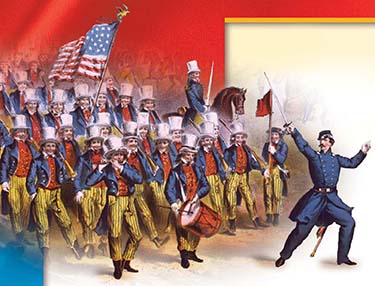SECTION 1: Resources, Strategies, and Early Battles

▲ An illustration shows Union volunteers, each dressed up like Uncle Sam, marching in a parade.
WITNESS HISTORY  AUDIO
AUDIO
Marching Off to War
When the war began, families on both sides watched as husbands and sons rushed to join the Union and Confederate armies. Often there were celebratory parades to cheer the soldiers on. As the men marched off, family members felt both sadness and pride. One Richmond resident noted these mixed emotions in her diary:
“An old lady, the mother of several dearly loved sons, but echoed the almost universal sentiment when she said … ‘War, I know is very dreadful, but if, by the raising of my finger, I could prevent my sons from doing their duty to their country now, though I love them as my life, I could not do it. I am no coward, nor have I brought up my boys to be cowards. They must go if their country needs them.’”
—Sallie Brock Putnam, Richmond During the War
Objectives
- Contrast the resources and strategies of the North and South.
- Describe the outcomes and effects of the early battles of the Civil War.
Terms and People
- blockade
- Robert E. Lee
- Anaconda Plan
- border state
- Stonewall Jackson
- George B. McClellan
- Ulysses S. Grant
- Shiloh
NoteTaking
Reading Skill: Categorize As you read, use a table to note the advantages of the North and the South at the beginning of the war.
| Union | Confederacy |
|---|---|
|
|
Why It Matters In 1861, the long, bitter dispute over slavery and states’ rights erupted into war. The first shots at Fort Sumter set the stage for a long, costly struggle. At stake was the survival of the United States. Section Focus Question: How did each side’s resources and strategies affect the early battles of the war?
Union and Confederate Resources
As the Civil War began, each side possessed significant strengths and notable weaknesses. At first glance, most advantages appeared to add up in favor of the Union.
Advantages of the Union
The North enjoyed a tremendous advantage in population. Some 22 million people lived in the states that stayed in the Union. By contrast, the Confederacy had a population of only 9 million, of whom 3.5 million were enslaved African Americans.
The industrialized North was far better prepared to wage war than the agrarian South. Most of the nation’s coal and iron came from Union mines, and the vast West was a source of gold, silver, and other resources. The densely populated urban areas of the Northeast supported a wide variety of manufacturing. With mechanized factories and a steady flow of European immigrants seeking work, the Union could produce more ammunition, arms, uniforms, medical supplies, and railroad cars than the Confederacy could. In addition, the Union had a larger railroad network for moving troops and material.




